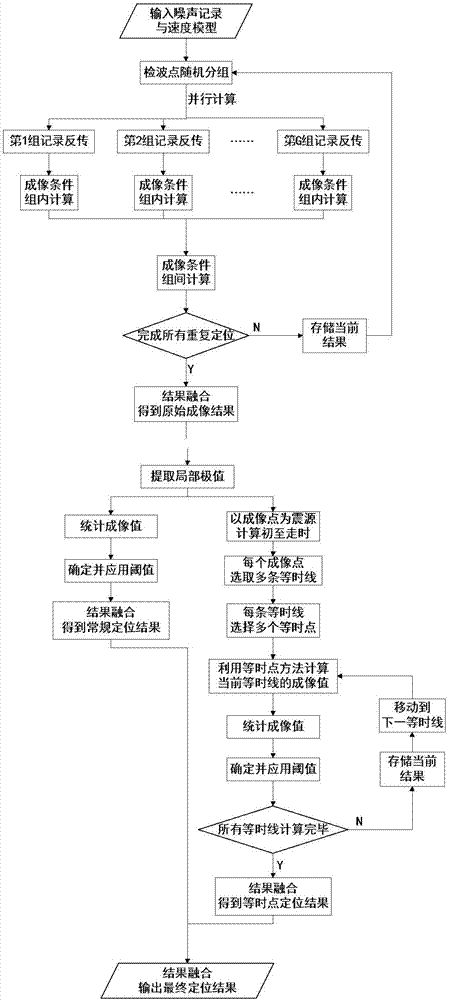Reverse-time Imaging Method of Noise Source Location at Multi-level Isochronous Points
A technology of noise source location and imaging method, applied in measurement devices, instruments, scientific instruments, etc., can solve problems such as unsatisfactory elimination effect, and achieve the effect of positioning efficiency, positioning accuracy, and good adaptability
- Summary
- Abstract
- Description
- Claims
- Application Information
AI Technical Summary
Problems solved by technology
Method used
Image
Examples
Embodiment 1
[0085] a. Input the noise record and underground velocity model; adopt a uniform model of 1043*302, the grid spacing is 10m, and 522 detection points are evenly distributed on the surface; the excitation of all noise sources is 0-1000ms, and different random sequences and 30Hz mine The convolution of the Kelet wavelet is used as the wavelet; the time sampling interval is 1ms, the duration of the noise source is 3000-4000ms, and the total recording time is 4000ms; the source distribution is 10 sources scattered in a uniform medium of 3000m / s ( Figure 6 (a));
[0086] b. Using the conventional reverse time imaging method to obtain the original imaging results, using a mixed imaging condition
[0087]
[0088] As the imaging condition, where, I l (x)(l∈Z + ) represents the imaging value at spatial position x, R i (x,t) represents the wave field value from the ith detection point at the spatial position x and the backpropagation time t, G is the number of detection point gr...
Embodiment 2
[0098] a. Input the noise record and underground velocity model; adopt a uniform model of 1043*302, the grid spacing is 10m, and 522 detection points are evenly distributed on the surface; the excitation of all noise sources is 0-1000ms, and different random sequences and 30Hz mine The convolution of the Kelet wavelet is used as the wavelet; the time sampling interval is 1ms, the duration of the noise source is 3000-4000ms, and the total recording time is 4000ms; the source distribution is 10 sources scattered in a uniform medium of 3000m / s ( Figure 6 (a)); In order to test the influence of white noise on this method, white noise is added to the forward modeling record, and the record at the center detection point is extracted ( Figure 7 (a) compared with (b));
[0099] b. Using the conventional reverse time imaging method to obtain the original imaging results, using a mixed imaging condition
[0100]
[0101] As the imaging condition, where, I l (x)(l∈Z + ) represent...
PUM
 Login to View More
Login to View More Abstract
Description
Claims
Application Information
 Login to View More
Login to View More - R&D
- Intellectual Property
- Life Sciences
- Materials
- Tech Scout
- Unparalleled Data Quality
- Higher Quality Content
- 60% Fewer Hallucinations
Browse by: Latest US Patents, China's latest patents, Technical Efficacy Thesaurus, Application Domain, Technology Topic, Popular Technical Reports.
© 2025 PatSnap. All rights reserved.Legal|Privacy policy|Modern Slavery Act Transparency Statement|Sitemap|About US| Contact US: help@patsnap.com



